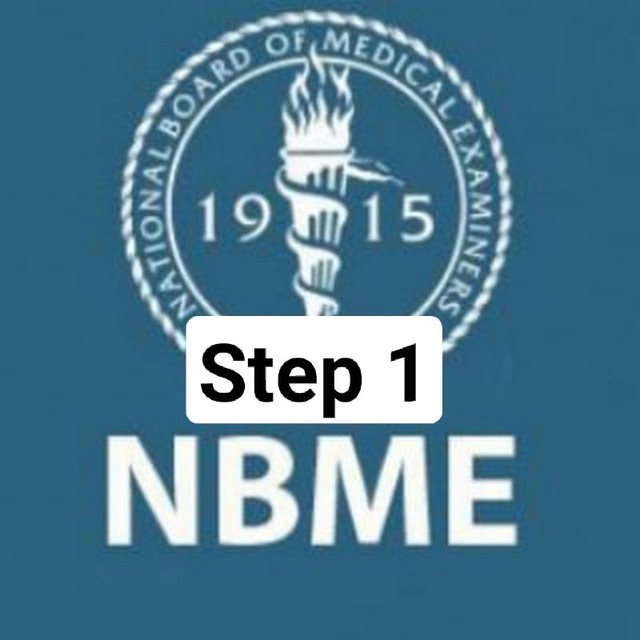▫️Right way to use NBME FORMS (online ,offline Step 1 270+)
▫️This channel contain All National Board Medical Exams (NBME)s with provided Answers
▫️Last Updated NBMEs NEWS
Uworld step 1 2021
https://t.me/Uworldstp1
Recent Posts
🚀 Free Trial + Special Discount on NBME Way! 🚀
#NBME_step2ck_Qbank
✅ Quick sign-up at
https://nbmeway.com/nbme/signup.php
#USMLEPrep#NBMEWay#StudySmart
#NBME_step2ck_Qbank
✅ Quick sign-up at
https://nbmeway.com/nbme/signup.php
#USMLEPrep#NBMEWay#StudySmart
NBME STEP 1 | USMLE pinned a photo
🚀 Free Trial + Special Discount on NBME Way! 🚀
#NBME_step2ck_Qbank
Unlock your USMLE prep potential with a free trial and exclusive discounts at NBME Way. Limited spots!
✅ Quick sign-up at
https://nbmeway.com/nbme/signup.php
✅ Expert resources
✅ Maximize your scores
Secure your success - enroll now and elevate your study game!
Need help? Chat with us on Telegram: @nbmeway
#USMLEPrep#NBMEWay#StudySmart
#NBME_step2ck_Qbank
Unlock your USMLE prep potential with a free trial and exclusive discounts at NBME Way. Limited spots!
✅ Quick sign-up at
https://nbmeway.com/nbme/signup.php
✅ Expert resources
✅ Maximize your scores
Secure your success - enroll now and elevate your study game!
Need help? Chat with us on Telegram: @nbmeway
#USMLEPrep#NBMEWay#StudySmart
⏱️ Hurry up! This exclusive offer is only valid for one week!🏃♂🏃🏃♀🚀
@CBSE_CCSE_SHELF_EXAMS
♦️https://t.me/CBSE_CCSE_SHELF_exam
Educational objective: Lesions of the jugular foramen can result in jugular foramen (Vernet) syndrome, which is characterized by the dysfunction of cranial nerves IX, X, and XI. Symptoms include dysphagia, hoarseness, loss of gag reflex on the ipsilateral side, and deviation of the uvula toward the normal side.
A 67-year-old woman with a known history of lung cancer comes to the office due to hoarseness and
difficulty swallowing. She has no disturbances in vision or hearing. On examination, there is loss of the gag reflex on the left side; when the patient is prompted to say "ah," the uvula deviates to the right side.
a right lower lobe lung mass and several osteolytic rib lesions. MRI of the head also demonstrates multiple Her left shoulder is drooped and strength is reduced during left shoulder shrug testing. Chest x-ray shows
lesions consistent with metastasis.
difficulty swallowing. She has no disturbances in vision or hearing. On examination, there is loss of the gag reflex on the left side; when the patient is prompted to say "ah," the uvula deviates to the right side.
a right lower lobe lung mass and several osteolytic rib lesions. MRI of the head also demonstrates multiple Her left shoulder is drooped and strength is reduced during left shoulder shrug testing. Chest x-ray shows
lesions consistent with metastasis.
A 67-year-old woman with a known history of lung cancer comes to the office due to hoarseness and
difficulty swallowing. She has no disturbances in vision or hearing. On examination, there is loss of the gag reflex on the left side; when the patient is prompted to say "ah," the uvula deviates to the right side.
a right lower lobe lung mass and several osteolytic rib lesions. MRI of the head also demonstrates multiple Her left shoulder is drooped and strength is reduced during left shoulder shrug testing. Chest x-ray shows
lesions consistent with metastasis.
difficulty swallowing. She has no disturbances in vision or hearing. On examination, there is loss of the gag reflex on the left side; when the patient is prompted to say "ah," the uvula deviates to the right side.
a right lower lobe lung mass and several osteolytic rib lesions. MRI of the head also demonstrates multiple Her left shoulder is drooped and strength is reduced during left shoulder shrug testing. Chest x-ray shows
lesions consistent with metastasis.
A 55-year-old man with poorly controlled hypertension and type 2 diabetes mellitus comes to the emergency department due to difficulty seeing. He has had blurry vision for the last 2 weeks, and 1 day ago he suddenly noticed a shadow develop across the visual field of his left eye. The patient has no recent headache, double vision, vertigo, light sensitivity, or nausea. On examination, pupils are equal and reactive to light. There is an area of reduced vision in the left eye. Funduscopic examination reveals a flameshaped hemorrhage in the left temporal hemiretina.
Educational objective: Patients with suspected cryptococcal meningitis can be diagnosed using India ink staining of the cerebrospinal fluid. Treatment with amphotericin B and flucytosine is required at first, followed by long-term fluconazole maintenance therapy.
A 28-year-old man comes to the emergency department due to 2 weeks of headaches, fever, and episodes of inattentiveness. The patient has a history of Hodgkin lymphoma and is undergoing treatment with combination chemotherapy. Temperature is 38.2 C (100.8 F), blood pressure is 138/84 mm Hg, and pulse is 72/min. Lumbar puncture reveals an elevated opening pressure, and cerebrospinal fluid analysis shows moderately increased protein levels and low glucose levels. Light microscopy of the cerebrospinal fluid is shown in the image.
🔰♦️CBSE CCSE AND SHELF EXAMS 😍👌
👌 Save this list for a rainy day 😉
👌 Save this list for a rainy day 😉
Educational objective: Infection of the medial face, sinuses (ethmoidal or sphenoidal), or teeth may spread through the valveless facial venous system into the cavernous sinus, resulting in cavernous sinus thrombosis. Patients typically present with headache, fever, proptosis, and ipsilateral deficits in cranial nerves Ill, IV, VI, and V (ophthalmic and maxillary branches).
A 48-year-old man comes to the hospital after a day of high-grade fever, progressive headache, and double vision. The patient has been having purulent nasal drainage and frontal headache for the past several days. He has a history of type 2 diabetes mellitus. His temperature is 38.9 C (102 F), blood pressure is 110/70 mm Hg, and pulse is 94/min. Physical examination shows ptosis, mydriasis, mild proptosis, and loss of the corneal reflex of the right eye. Visual acuity is normal in both eyes, but the patient is unable to move the right eye in any direction. There is decreased sensation in the right upper face.
Educational objective: Cryptococcus neoformans causes meningoencephalitis in patients with untreated AIDS. Diagnosis can be made by detecting the polysaccharide capsule in cerebrospinal fluid using the latex agglutination test. India ink staining of cerebrospinal fluid is also used for diagnosis and can demonstrate round or oval budding yeast.
A 54-year-old man is brought to the emergency department due to a week of progressive headaches and confusion. He was treated for viral esophagitis 6 months ago and Pneumocystis pneumonia 2 months ago. Temperature is 38 C (100.4 F), blood pressure is 142/86 mm Hg, and pulse is 64/min. The patient is lethargic and oriented to person and place only. CT scan of the head shows a mildly increased ventricle size but no other abnormalities. Lumbar puncture reveals an elevated opening pressure, and cerebrospinal fluid analysis shows moderately increased protein concentration and pleocytosis. The latex agglutination test is positive for soluble polysaccharide antigen.






